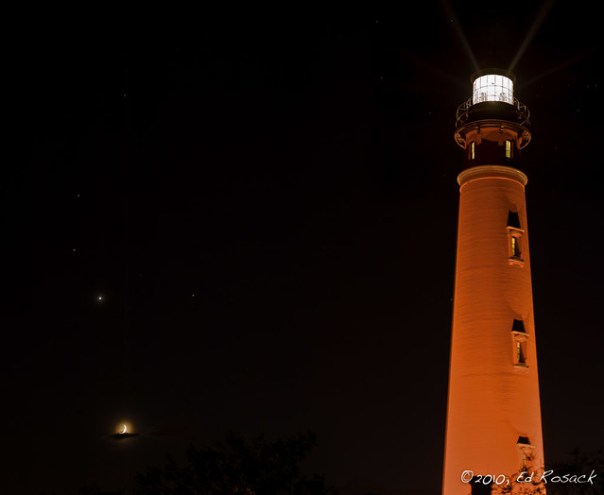Kevin M, Robert W, Tom M, Lutfi E, and I met at Parish Park in Titusville last weekend for a photo excursion. We got there well before sunrise and had time for a few night photos.

Stars above the causeway at Parrish Park – Looking SW, before dawn.
When we’d all arrived, we carpooled over to East Gator Creek Road for sunrise. Since it was so clear before dawn, I didn’t think it would be very good. But once again, Mother Nature surprised me, and a set of clouds moved in to add interest and color to the sky.
After daybreak, we drove on around East Gator Creek Road and then Black Point Wildlife Drive looking for birds. We didn’t have to look too hard – they’re out force!
We saw many species and huge numbers of some of them. White Pelicans were especially plentiful, both foraging in the water and soaring above us. There were other huge formations of ducks flying over, but they were too high for me to ID. One smaller flock flew very low right down the road. I didn’t see them coming and the noise when they passed startled me.
We also saw Ring billed Gulls, a Bonaparte’s Gull, a some Forster’s Terns, Least Terns, a Black Skimmer, Northern Shovelers, Northern Pintails, Blue winged Teals, Lesser Scaups, Red Breasted Mergansers, Hooded Mergansers, Pied billed Greebes, Greater Yellowlegs, Sandpipers, Killdeer, Roseate Spoonbills, a Bald Eagle, Ospreys, Loggerhead Shrikes, Savanah Sparrows, Red winged Blackbirds, White Ibis, Glossy Ibis, Wood Storks, Reddish Egrets, a White Morph Redish Egret, Great Egrets, Snowy Egrets, Great Blue Herons, Tri-colored Herons, Belted Kingfishers, and maybe a few others.
Highlights also included a very cooperative Shrike that sat still while we all made way too many photos of it, a bald eagle that flew right overhead, and two life birds for me (the Bonaparte’s Gull and Greater Yellowlegs). It’s definitely birding season at MINWR!
As a side note: I got an email from a Flickr contact that’s going to be in the area for a couple of days. They wanted some hints on how to see everything while they’re here, especially Gatorland, Viera Wetlands, and Merritt Island. I did pass along some hints. But then I had to tell them that’s a lot to see in 2 days! The good news is that you’re almost certain to see some good things in those places. The bad news is that you can’t possibly see everything in that short a time – it’s just too large an area and the weather / wildlife might not cooperate. The key is to relax, enjoy being there and be ready with your camera for whatever comes your way. I hope I’m not misleading people into thinking that they can photograph all the things they see here on the blog on their first time out. It takes persistence and even some luck.
Anyway, if you’ve wanted to go to MINWR, now’s the time. You can see other posts I’ve written about MINWR here and you can see larger versions of the photos above and others from Merritt Island in this set on Flickr.
Thanks for stopping by and reading my blog. Now, go make some photos!
©2014, Ed Rosack. All rights reserved.























